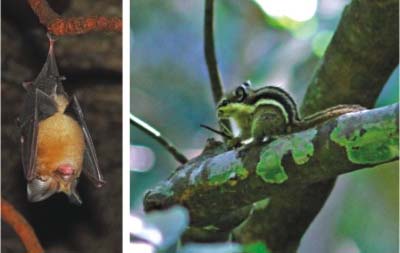 Two new species of mammals have been discovered in Bangladesh, taking the total number of mammals of the country to 124.
Two new species of mammals have been discovered in Bangladesh, taking the total number of mammals of the country to 124.
The Himalayan Striped Squirrel (Tamiops macclellandi) and Least Leaf-nosed Bat (Hipposideros cineraceus) are only the second and third new mammals to be found in the country in last five years.
The first new mammal, Yellow Martin, was found early this year.
Both the new species were discovered in an expedition in the remote hills of Bandarban by Dr Monirul Khan, associate professor of zoology, Jahangirnagar University in November.
“Finding any new wildlife species for the country is very rare. So the discovery of two new species is very significant,” said Dr Monirul Khan.
Usually found in India, Nepal, Myanmar and some Southeast Asian countries, the two species were never seen in the country before.
Himalayan Striped Squirrel is a small brownish squirrel with longitudinal black, brown and buff stripes along its back from behind the eye up to the base of the tail.
With a total length of only 22 centimetres (head-body 11cm and tail 11cm), the striped squirrel is now the smallest of the nine species of squirrels so far recorded in Bangladesh.
When Dr Khan found the squirrel, it was seen feeding on a large brown stick insect and moving swiftly among the branches of trees of the forest in Thaikkang, Ruma, Bandarban.
Least Leaf-nosed Bat, the other new species, is a small bat with head-body length of only 3.7cm. The body hairs are dull brown to orange in upper parts and pale to almost white in under parts.
Its wings and large external ears are dark. There is a small leaf-like structure at the tip of the nose, hence it is called ‘leaf-nosed’ bat.
Dr Khan discovered a few dozen of this species inside a natural cave near Boga Lake in Ruma, Bandarban.
In the week-long expedition, the zoology professor also found a number of rare birds including Pale-headed Woodpecker, Long-tailed Broadbill, Mountain Hawk Eagle, Striated Yuhina, Chestnut-bellied Nuthatch, Orange-bellied Leafbird, Mountain Imperial Pigeon, Maroon Oriole and Common Rosefinch.
The discovery not only proves that the country is still very rich in wildlife, but also indicates that there are many species yet to discover, said Dr Khan.
But the rich wildlife in the Chittagong Hill Tracts will not sustain unless steps are taken seriously to conserve the existing forest patches and control the hunting for meat, he said.
Article courtesy: The Daily Star Image courtesy: Monirul Khan



